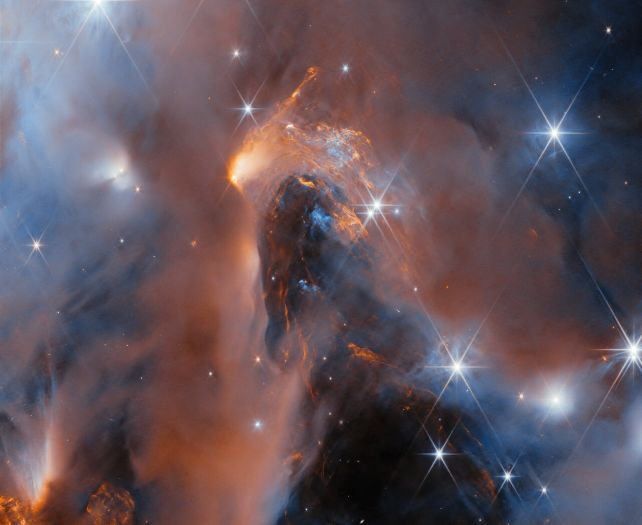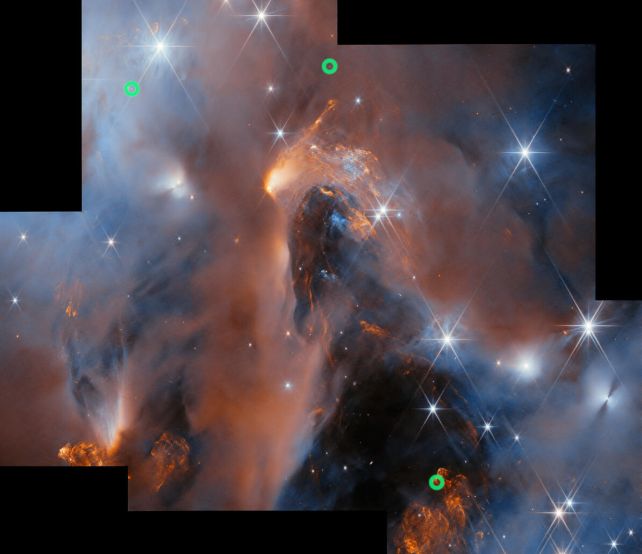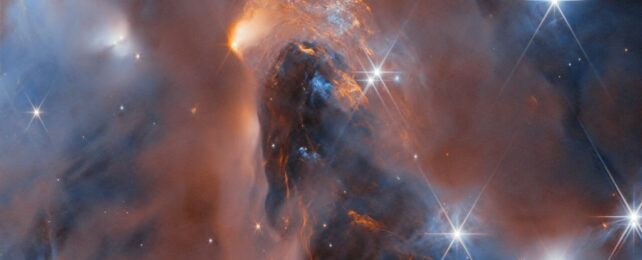We think of planets as the inherently confined children of host stars.
Space, however, is a strange and mercurial thing; objects do not always follow the rules we think they ought.
Using JWST, astronomers have caught six 'rogue', planet-sized objects, zooming untethered to any star, wild and free through interstellar space, in the gorgeous environment of a star-forming nebula in the constellation of Perseus.
"We are probing the very limits of the star forming process," says astrophysicist Adam Langeveld of Johns Hopkins University.
"If you have an object that looks like a young Jupiter, is it possible that it could have become a star under the right conditions? This is important context for understanding both star and planet formation."
There are a couple of ways we can build a cosmic object. Stars are thought to form top-down: a clump in a suitably dense cloud of dust and gas collapses under gravity and accumulates more and more mass from a disk of material that swirls around it until the pressure and heat at its center are high enough to ignite hydrogen fusion.
At least some planets are thought to form from a bottom-up process, from the material left behind in the disk when the star finishes forming. In this scenario, clumps of material start to stick together electrostatically, then gravitationally, eventually building up enough material to form a differentiated core and mantle.
It's unclear where the boundary lies between these formation mechanisms. And it was this question that drove the researchers to point JWST at a nebula called NGC 1333 in Perseus, a region filled with clusters of young stars newly formed from the gas within.

"We used Webb's unprecedented sensitivity at infrared wavelengths to search for the faintest members of a young star cluster, seeking to address a fundamental question in astronomy: How light an object can form like a star?" says astrophysicist Ray Jayawardhana of Johns Hopkins University.
"It turns out the smallest free-floating objects that form like stars overlap in mass with giant exoplanets circling nearby stars."
Astronomers estimate that there could be billions of rogue planets, drifting through the Milky Way. A large proportion of these would have formed in the usual way, in the leftovers of the meal devoured by a baby star; hectic gravitational interactions could free these worlds of their stellar moorings and send them off to have star-free adventures (or become snared by the gravity of an alien star).
But it's possible that some rogue planets start their development in the same way as stars do. We know of a population of objects that form like stars, but don't get enough mass for hydrogen fusion; these are the brown dwarfs, between about 13 and 85 times the mass of Jupiter. These objects are massive enough to support the fusion of deuterium – a form of heavy hydrogen whose fusion requires lower pressure and temperature. They glow, but dimly.
Modeling suggests that the upper mass limit for a planet to form bottom-up, through core accretion, is less than 10 Jupiters. In addition, the population of NGC 1333 is young, and such accretion would take a bit of time – as would the gravitational interactions that would yeet them out into the big, wide galaxy.

So when JWST spotted six objects between five and ten times the mass of Jupiter, Langeveld and his team thought they must have formed from gravitational collapse. This was confirmed when they found disks around each of the relatively tiny objects, just like baby stars in miniature.
"Our observations confirm that nature produces planetary mass objects in at least two different ways – from the contraction of a cloud of gas and dust, the way stars form, and in disks of gas and dust around young stars, as Jupiter in our own solar system did," Jayawardhana says.
Interestingly, although JWST is sensitive enough to detect even smaller objects, the researchers found no rogue worlds smaller than five Jupiters. This suggests that this is the cutoff point. Below that mass, it's likely planets need to form via core accretion.
The team's findings suggest that these objects are plentiful, accounting for as many as 10 percent of all objects in the cluster they studied. And the discovery of these worlds suggests fascinating possibilities, blurring the line between a star and its planets, and a planet and its moons.
"Those tiny objects with masses comparable to giant planets may themselves be able to form their own planets," says astrophysicist Aleks Scholz of the University of St Andrews in the UK. "This might be a nursery of a miniature planetary system, on a scale much smaller than our Solar System."
The research has been accepted into The Astronomical Journal, and is available on arXiv.
